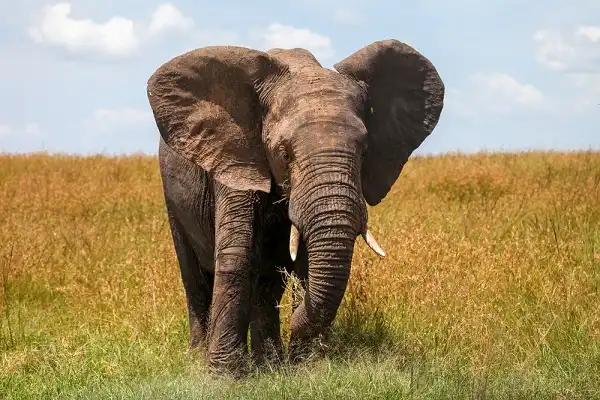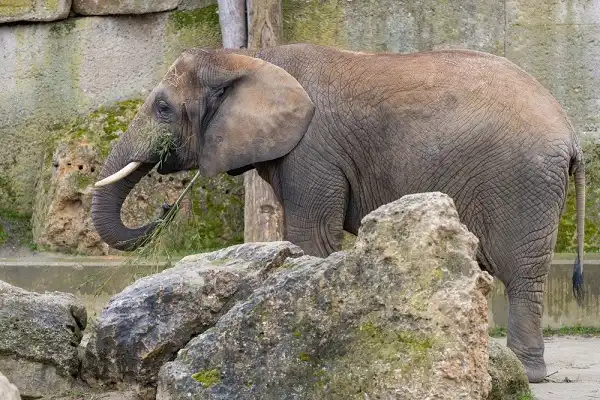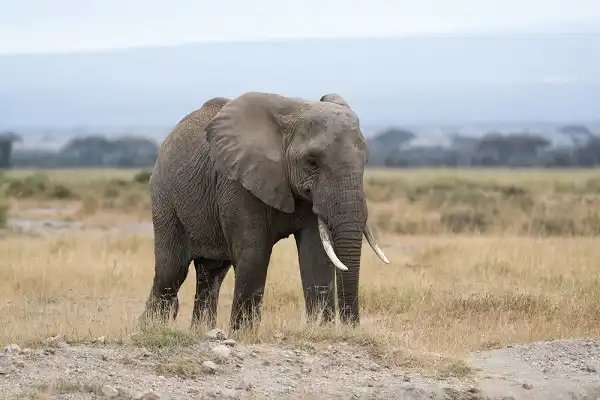Roaming the African savannas for thousands of years, the African bush elephant is an amazing and enigmatic creature. With its massive size and dauntless strength, it commands respect from all who behold it in nature. But behind this awe-inspiring facade lies a gentle soul that has seen much sorrow in its existence due to decades of poaching and habitat destruction. This blog post will explore the anatomy, behavior, adaptations, and conservation efforts associated with the African bush elephant; topics which will not only expand our knowledge of these incredible animals but also allow us to better understand how we should be protecting them as part of their legacy long into our future.

African Bush Elephant Description
The African bush elephant is one of the largest land animals on Earth. They have thick, gray skin that is sparsely covered in hair, with long tusks protruding from their upper lip. Elephants also have large ears which help them keep cool in hot climates and long trunks that are used for grasping and drinking water. While their impressive size can be intimidating, they are surprisingly graceful creatures with a gentle nature. Their feet are equipped with four toes to provide maximum stability on all terrain types, while their front legs are longer than their back to make it easier for them to carry heavy loads over extended distances.
African Bush Elephant Habitat
The natural habitat of the African bush elephant is the savannas of Southern and Eastern Africa. They often roam in large herds of as many as 100 individuals that can cover up to 30 miles each day in search of food and water. These animals live in grasslands, woodlands, wetlands, and even forests provided there is enough space for them to move around. Elephants also need access to mudholes and rivers as they use these not only for drinking but also for bathing and playing. In addition to food sources, elephants also need access to minerals like salt which they obtain by digging up soil with their tusks; a behavior known as “browsing”. This helps them get essential nutrients like calcium which is especially important for growing calves. Overall, African bush elephants require a wide variety of resources in order to survive in the wild which is why it is so important that we protect their habitats from destruction caused by humans. Without healthy ecosystems, they will be unable to thrive in the future.
African Bush Elephant Diet
The African bush elephant is an herbivore species and has a diet that consists mainly of grasses, leaves, twigs, bark, roots, and fruits. They use their long trunks to pluck these items from the ground or trees as they travel in their herds. Despite their large size, elephants only need to eat about 300 pounds of food each day in order to survive. In addition to vegetation, African bush elephants also need access to minerals like salt which they obtain by digging into the ground with their tusks; a behavior known as “browsing”. This helps them get essential nutrients like calcium which is especially important for growing calves.
Elephants will also sometimes consume soil or clay in order to absorb essential minerals from the Earth that are not found in other foods. Elephants have complex digestive systems that enable them to break down plant material efficiently so they can extract energy from it quickly and move on without having to stop and rest for long periods of time. Although they primarily feed during daylight hours, African bush elephants have been known to graze late into the night when necessary in search of food sources if conditions are suitable.

African Bush Elephant Size
The African bush elephant is one of the largest land animals on Earth, towering at an average of 8-12 feet tall and weighing around 6-7 tons. They have long, bulky bodies and thick gray skin that is sparsely covered in hair. Their impressive size can be intimidating but they are surprisingly graceful creatures with a gentle nature. The combination of their powerful muscular frame, impressive strength, and agile movements make African bush elephants perfectly adapted for life in the wild as they roam across the savannas of Southern and Eastern Africa looking for food and water sources every day.
African Bush Elephant Lifespan
The African bush elephant is a long-lived species, with an average lifespan of between 50 and 70 years in the wild. However, some individuals have been known to live even longer, reaching up to 80 years old in captivity. Female elephants usually live longer than males due to better health and nutrition as well as higher protection from predators. Elephants have a slow reproductive cycle, meaning their population growth is much slower than other animals. This is why their population has been so heavily impacted by illegal poaching which has led to a severe decline in numbers over the years. In order for African bush elephants to reach their full potential lifespan they must be afforded the necessary resources and protection from threats such as poaching and habitat destruction. In addition to this, they require large amounts of food and water each day which can be scarce in some areas due to climate change or human activity. As such, conservation efforts are key in ensuring that these majestic creatures can continue living peacefully in their natural environment for many years to come.
African Bush Elephant Behavior
African bush elephants are highly social animals who live in extended family units consisting of related females and their young. These herds are led by an older female known as the matriarch, who is usually the oldest and most experienced member. They will stick together and migrate towards areas with abundant resources like food and water while avoiding dangerous predators like lions or hyenas. Elephants communicate with one another through a variety of low-frequency calls which can travel for miles across open plains. This allows them to stay in contact with members of their herd even when separated by large distances.
They also use body language to express themselves and show affection towards one another such as intertwining their trunks or rubbing heads. African bush elephants will often have long-term relationships with certain individuals outside their own herd, forming strong bonds that appear to be based on mutual trust and acceptance rather than hierarchy or dominance. For instance, they may form alliances with other species like antelopes or zebras which helps protect them from predators while providing these animals with safety in numbers from larger threats.

African Bush Elephant Speed
African bush elephants are surprisingly agile and powerful creatures that can run at speeds of up to 25 mph, making them the fastest land animal in Africa. They use this incredible burst of speed to outrun predators or escape danger when necessary. However, they can only maintain this pace for short distances and must rely on their powerful muscles and endurance for longer journeys over various terrain types. Elephants are also adept swimmers who can hold their breath underwater for up to 12 minutes while traveling at speeds of up to 6 mph.
This is a useful skill in areas with large bodies of water as it allows them to cross rivers without being exposed to predators on the other side. When moving across open plains African Bush elephants typically travel at a more leisurely pace between 5-7mph which allows them not only to cover greater distances but also conserve energy and resources as they search for food sources if conditions are suitable. They are capable of walking nonstop for days on end, often covering over 500 miles in a single migration season with minimal rest periods required along the way.
African Bush Elephant Hunting
African bush elephants are usually not actively hunted as they are a protected species. However, they can sometimes be targeted by poachers for their ivory tusks or meat. This illegal activity has had a severe impact on elephant populations across the continent and continues to be a major threat to their survival today. Poaching is often facilitated by weak law enforcement and corruption which can lead to the hunting of young elephants who have not yet reached maturity. In some cases, poachers will even kill entire herds in order to maximize their profits quickly. This type of indiscriminate killing can have catastrophic consequences for elephant populations as it disrupts family units and can reduce reproductive success amongst survivors. In addition to poaching, African bush elephants are also threatened by habitat destruction due to human activities such as logging, mining, and agricultural expansion which reduces the availability of resources for these animals and limits the areas in which they can roam freely.
African Bush Elephant Reproduction and Life Cycle
African Bush Elephant reproduction and the life cycle are quite fascinating. Female African Bush Elephants reach sexual maturity around the age of 11 and males typically become sexually mature between the ages of 16-20. Breeding usually takes place during the wet season when resources are plentiful and there is plenty of food to sustain a young calf. The gestation period for an African Bush Elephant is 22 months, one of the longest gestations for any mammal, which explains why females only give birth to one calf approximately every five years.
The female will usually stay close to her newborn calf for several weeks as she nurses it and teaches it important skills such as how to feed and recognize potential threats in its environment. When a calf reaches 2 years old it will leave its mother’s herd in order to form its own social unit with other juveniles or even bachelor males. As they grow older, male elephants may join wandering bull groups while females may remain solitary or join other extended families.

Conclusion
The African Bush Elephant is an iconic species that has captivated the attention of many for its impressive size, powerful speed and agility, and unique social behavior. However, it is also in danger due to poaching and habitat destruction which have both had devastating impacts on populations across the continent. To protect these animals from further decline conservation efforts must be increased and tougher laws enforced to prevent illegal hunting practices. By learning more about their life cycles and reproductive behavior we can gain a greater appreciation for this remarkable species which plays a very important role in Africa’s diverse ecology.
Frequently Asked Question


